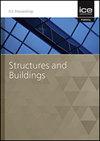Modelling nonlinear dynamic behaviour of rocking bridge piers with shape memory alloys
IF 1.4
4区 工程技术
Q3 CONSTRUCTION & BUILDING TECHNOLOGY
Proceedings of the Institution of Civil Engineers-Structures and Buildings
Pub Date : 2023-05-17
DOI:10.1680/jstbu.22.00219
引用次数: 0
Abstract
In recent years, accelerated bridge construction (ABC) has led to substantial application of precast post-tensioned segmental (PPS) bridge piers. However, PPS piers are not widely used in high-seismicity regions due to their low energy-dissipation capacity. To address this deficiency, this research work examines a series of Shape Memory Alloy (SMA) concrete composite PPS piers. Nonlinear static and dynamic analyses are performed on experimentally validated Finite Element (FE) models of the SMA concrete composite piers, and the results are compared with those without SMA bars. It is found that length, area, and post-tensioning ratio of the SMA bars affect the energy dissipation capacity of the piers, and an optimal design of the bars is required to reach the highest energy dissipation possible. The effects of the SMA bars on the frequency response functions of the piers are investigated for the first time in this study, and it is shown that, unlike the piers without SMA bars, the sub-harmonics and super-harmonics are not seen in the response of the SMA concrete composite piers, mainly for the drift responses. Further, the SMA concrete composite piers experience a significant reduction in the drift responses compared to those without SMA.用形状记忆合金模拟摇摆桥墩的非线性动力行为
近年来,加速桥梁建设(ABC)导致了预制后张节段(PPS)桥墩的大量应用。然而,PPS桥墩由于耗能能力较低,在高地震活动性地区并没有得到广泛应用。为了解决这一不足,本研究工作考察了一系列形状记忆合金(SMA)混凝土复合PPS桥墩。对经试验验证的SMA混凝土复合桥墩有限元模型进行了非线性静力和动力分析,并与未加SMA钢筋的桥墩进行了比较。研究发现,SMA筋的长度、面积和后张比影响着桥墩的耗能能力,需要对SMA筋进行优化设计,以达到最大的耗能能力。本文首次研究了SMA杆对桥墩频率响应函数的影响,结果表明,与不加SMA杆的桥墩不同,SMA混凝土复合桥墩的响应中没有亚谐波和超谐波,主要是漂移响应。此外,与没有SMA的桥墩相比,SMA混凝土复合桥墩的漂移响应显著降低。
本文章由计算机程序翻译,如有差异,请以英文原文为准。
求助全文
约1分钟内获得全文
求助全文
来源期刊
CiteScore
3.40
自引率
6.20%
发文量
61
审稿时长
12 months
期刊介绍:
Structures and Buildings publishes peer-reviewed papers on the design and construction of civil engineering structures and the applied research associated with such activities. Topics include the design, strength, durability and behaviour of structural components and systems.
Topics covered: energy conservation, people movement within and around buildings, strength and durability of steel and concrete structural components, and the behaviour of building and bridge components and systems

 求助内容:
求助内容: 应助结果提醒方式:
应助结果提醒方式:


